
The Aztecs were a Mesoamerican culture that flourished in central Mexico in the post-classic period from 1300 to 1521. The Aztec people included different ethnic groups of central Mexico, particularly those groups who spoke the Nahuatl language and who dominated large parts of Mesoamerica from the 14th to the 16th centuries. Aztec culture was organized into city-states (altepetl), some of which joined to form alliances, political confederations, or empires. The Aztec Empire was a confederation of three city-states established in 1427: Tenochtitlan, city-state of the Mexica or Tenochca; Texcoco; and Tlacopan, previously part of the Tepanec empire, whose dominant power was Azcapotzalco. Although the term Aztecs is often narrowly restricted to the Mexica of Tenochtitlan, it is also broadly used to refer to Nahua polities or peoples of central Mexico in the prehispanic era, as well as the Spanish colonial era (1521–1821). The definitions of Aztec and Aztecs have long been the topic of scholarly discussion ever since German scientist Alexander von Humboldt established its common usage in the early 19th century.
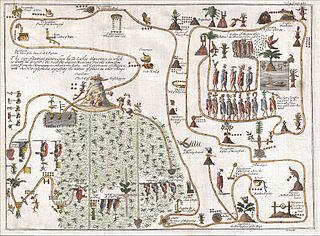
Aztlán is the ancestral home of the Aztec peoples. Astekah is the Nahuatl word for "people from Aztlan". Aztlan is mentioned in several ethnohistorical sources dating from the colonial period, and while they each cite varying lists of the different tribal groups who participated in the migration from Aztlan to central Mexico, the Mexica who went on to found Mexico-Tenochtitlan are mentioned in all of the accounts.

The Nahuas are a group of the indigenous people of Mexico, El Salvador, Guatemala, Honduras, and Nicaragua. They comprise the largest indigenous group in Mexico and second largest in El Salvador. The Mexica (Aztecs) were of Nahua ethnicity, and the Toltecs are often thought to have been as well, though in the pre-Columbian period Nahuas were subdivided into many groups that did not necessarily share a common identity.
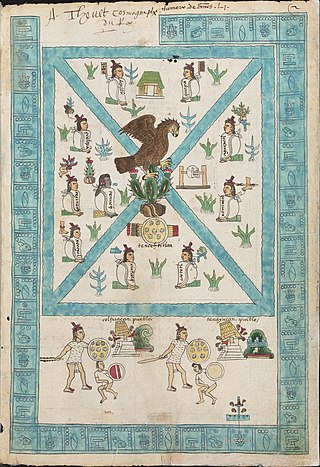
Aztec codices are Mesoamerican manuscripts made by the pre-Columbian Aztec, and their Nahuatl-speaking descendants during the colonial period in Mexico.
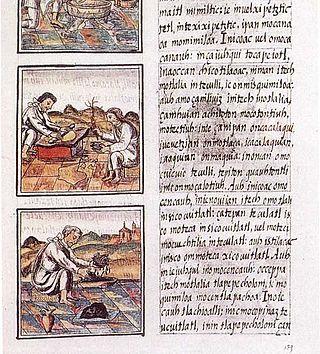
The Florentine Codex is a 16th-century ethnographic research study in Mesoamerica by the Spanish Franciscan friar Bernardino de Sahagún. Sahagún originally titled it: La Historia General de las Cosas de Nueva España. After a translation mistake, it was given the name Historia general de las Cosas de Nueva España. The best-preserved manuscript is commonly referred to as the Florentine Codex, as the codex is held in the Laurentian Library of Florence, Italy.
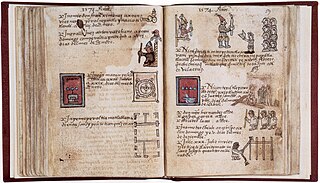
The Aubin Codex is an 81-leaf Aztec codex written in alphabetic Nahuatl on paper from Europe. Its textual and pictorial contents represent the history of the Aztec peoples who fled Aztlán, lived during the Spanish conquest of the Aztec Empire, and into the early Spanish colonial period, ending in 1608.
Domingo Francisco de San Antón Muñón Chimalpahin Quauhtlehuanitzin, usually referred to simply as Chimalpahin or Chimalpain, was a Nahua annalist from Chalco. His Nahuatl names mean "Runs Swiftly with a Shield" and "Rising Eagle", respectively, and he claimed descent from the lords of Tenango-Amecameca-Chalco. He was the grandson of the late Don Domingo Hernández Ayopochtzin, a seventh-generation descendant of the founding king of the polity. Don Domingo was learned and esteemed, especially for his education and his record-keeping skills in the ancient tradition.

The Spanish conquest of the Aztec Empire, also known as the Conquest of Mexico or the Spanish-Aztec War (1519–21), was one of the primary events in the Spanish colonization of the Americas. There are multiple 16th-century narratives of the events by Spanish conquistadors, their indigenous allies, and the defeated Aztecs. It was not solely a contest between a small contingent of Spaniards defeating the Aztec Empire but rather the creation of a coalition of Spanish invaders with tributaries to the Aztecs, and most especially the Aztecs' indigenous enemies and rivals. They combined forces to defeat the Mexica of Tenochtitlan over a two-year period. For the Spanish, the expedition to Mexico was part of a project of Spanish colonization of the New World after twenty-five years of permanent Spanish settlement and further exploration in the Caribbean.

The traditions of indigenous Mesoamerican literature extend back to the oldest-attested forms of early writing in the Mesoamerican region, which date from around the mid-1st millennium BCE. Many of the pre-Columbian cultures of Mesoamerica are known to have been literate societies, who produced a number of Mesoamerican writing systems of varying degrees of complexity and completeness. Mesoamerican writing systems arose independently from other writing systems in the world, and their development represents one of the very few such origins in the history of writing.

Alonso de Molina was a Franciscan priest and grammarian, who wrote a well-known dictionary of the Nahuatl language published in 1571 and still used by scholars working on Nahuatl texts in the tradition of the New Philology. He also wrote a bilingual confessional manual for priests who served in Nahuatl-speaking communities.

The Codex of Tlatelolco is a pictorial central Mexican manuscript containing a history of events occurring in Tlatelolco, from before 1550 to after 1564, in the period before and after the Spanish conquest of the Aztec Empire. Due to its name, it is sometimes confused with the Latin script, the manuscript Anales de Tlatelolco, also sometimes called the same name.

Tzilacatzin was a Tlatelolca warrior. A member of the Otomi or Otontin warrior class, he became famous as a hero during the Siege of Tenochtitlan.
Arthur James Outram Anderson was an American anthropologist specializing in Aztec culture and translator of the Nahuatl language.
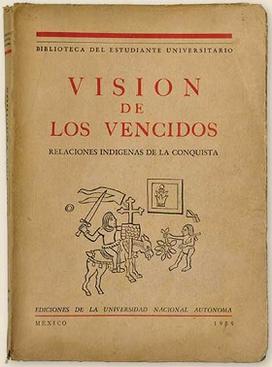
The Broken Spears: The Aztec Account of the Conquest of Mexico is a book by Mexican historian Miguel León-Portilla, translating selections of Nahuatl-language accounts of the Spanish conquest of the Aztec Empire. It was first published in Spanish in 1959, and in English in 1962. The most recent English edition was published in 2007 (ISBN 978-0807055007).

The Mexica were a Nahuatl-speaking indigenous people of the Valley of Mexico who were the rulers of the Aztec Empire. The Mexica established Tenochtitlan, a settlement on an island in Lake Texcoco, in 1325. A dissident group in Tenochtitlan separated and founded the settlement of Tlatelolco with its own dynastic lineage. In 1521, they were conquered by an alliance of Spanish conquistadors and indigenous people including the Tlaxcaltecs led by Hernán Cortés.
The Cantares Mexicanos is the name given to a manuscript collection of Nahuatl songs or poems recorded in the 16th century. The 91 songs of the Cantares form the largest Nahuatl song collection, containing over half of all known traditional Nahuatl songs. It is currently located in the National Library of Mexico in Mexico City. A description is found in the census of prose manuscripts in the native tradition in the Handbook of Middle American Indians.
New Philology generally refers to a branch of Mexican ethnohistory and philology that uses colonial-era native language texts written by Indians to construct history from the indigenous point of view. The name New Philology was coined by James Lockhart to describe work that he and his doctoral students and scholarly collaborators in history, anthropology, and linguistics had pursued since the mid-1970s. Lockhart published a great many essays elaborating on the concept and content of the New Philology and Matthew Restall published a description of it in the Latin American Research Review. The techniques of the New Philology have also been applied in other disciplines such as European medieval studies.

Francisco Jiménez was a colonial Nahua noble from Tecamachalco. He served as judge-governor of Tenochtitlan for a year and five months in 1568 and 1569, and was the first outsider to govern Tenochtitlan. Despite being a noble, the use of the honorific don with his name is inconsistent.

Tlatelolco was a pre-Columbian altepetl, or city-state, in the Valley of Mexico. Its inhabitants, known as the Tlatelolca, were part of the Mexica, a Nahuatl-speaking people who arrived in what is now central Mexico in the 13th century. The Mexica settled on an island in Lake Texcoco and founded the altepetl of Mexico-Tenochtitlan on the southern portion of the island. In 1337, a group of dissident Mexica broke away from the Tenochca leadership in Tenochtitlan and founded Mexico-Tlatelolco on the northern portion of the island. Tenochtitlan was closely tied with its sister city, which was largely dependent on the market of Tlatelolco, the most important site of commerce in the area.
Tetlepanquetzal was the fourth Tepanec tlatoani (ruler) of Tlacopan, and reigned after 1503 as a tributary of the Mexican emperor Moctezuma II, whom he assisted in the first defence of Mexico. Afterward he was one of the principal auxiliaries of Cuauhtémoc. When the city was finally taken, 13 August, 1521, he was made prisoner and tortured, together with Cuauhtémoc, by the Spaniards to coerce them into revealing the hiding place of the imperial treasure.














